How To Learn Landscape Design
It's tempting, in a field as subjective as garden design, to feel that rules do non apply. However, later 28 years and hundreds of projects later, I've come to believe in certain rules and guidelines that are neither fussy nor constraining. All accept proven invaluable to me over my years of garden-making. Applied by any gardener, apprentice or professional, they will issue in a more successful, satisfying blueprint.
Free newsletter with garden design tips every Thursday!
Let's start with two rules that can kicking-start the process of laying out a mural, then move on to guidelines that assistance in scaling the proportions of a garden's elements and, finally, to choosing and using the correct plants.
01: OBEY THE "Police force" OF Significant ENCLOSURE
Aye, this one's a "police force," non just a rule! It addresses the root pregnant of garden, which is "enclosure." This, to me, is absolutely critical in creating a sense of refuge and of feeling oneself inside nature'due south embrace. The police force of pregnant enclosure says that we feel enclosed when the vertical edge of a space is at to the lowest degree i-third the length of the horizontal space nosotros're inhabiting. Probably derived from behavioral psychology studies, this dominion came to me from a professor in graduate schoolhouse, and it was one of the best things I learned.
Just yesterday, as I was starting the design of a patio that I wanted to separate from an side by side play area, it gave me instant guidance for how tall a hedge I would need: the area was 17 feet broad, then my hedge should be at least 6 anxiety. Sit near a tree in the park, or a wall, and gradually edge away, and you'll come across how it works. Of course, at that place are times when the indicate of a mural design is a monumental sense of scale or view, only the best gardens, whatever their size, modulate a feeling of enclosure and openness, and this rule will help.
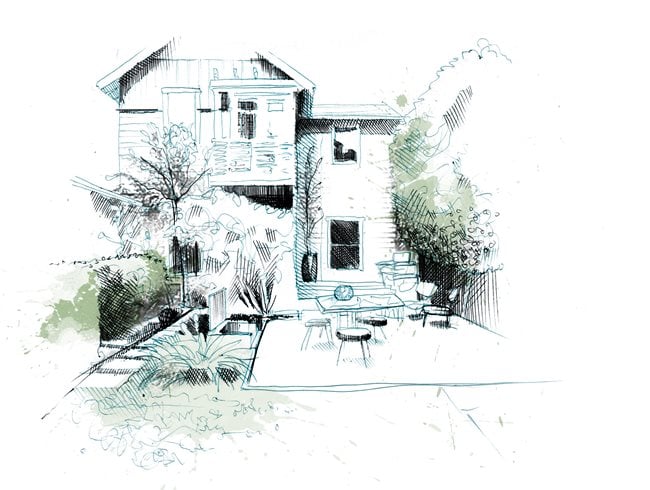
On this projection in Pacific Palisades, CA, an existing and overgrown row of ficus was reduced by half knowing it would still more than than adequately enclose the patio. Illustration past David Despau.
02: FOLLOW THE REGULATING LINE
My formal architectural education also introduced me to the concept of the "regulating line." The idea is that an element of architecture (for instance, a doorway, or a building edge, even a window mullion) or a distinctive landscape feature (prominent tree, existing pool, holding boundary) tin can "generate" an imaginary line that helps connect and organize the design. For instance, in laying out i backyard, I projected the lines of its building addition into the garden infinite so aligned the pond pool and wooden walkway with those lines. The result is orderly and cohesive, even after beingness softened with planting. "A regulating line," wrote the slap-up architect (and theoretician) Le Corbusier, "is an assurance against capriciousness…Information technology confers on the work the quality of rhythm…The option of a regulating line fixes the fundamental geometry of the work...."
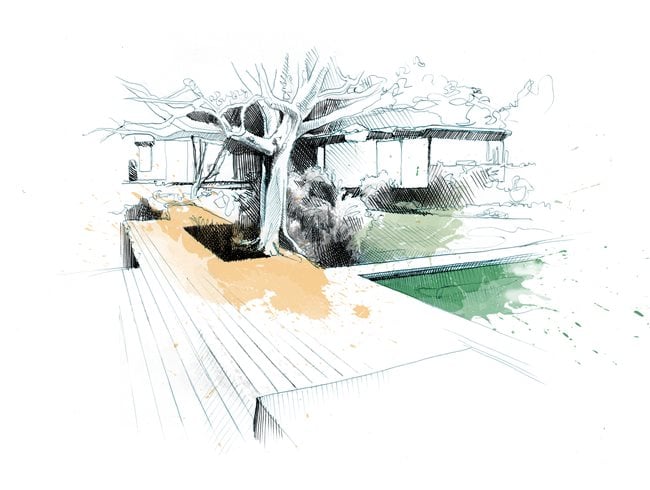
The decking on a different project in Pacific Palisades, CA, creates a regulating line that is parallel to the aeroplane create by the greyness wall of the house in the upper right of the paradigm. Another regulating line is created by the border of the pool running parallel to the glass window on the domicile. These lines intersect at the base of the tree. Illustration by David Despau.
Le Corbusier hits on the two aspects (a bit paradoxical, perhaps) that make the regulating line then valuable. Showtime is the idea of underlying social club: that the garden, for all its naturalness, or wildness, is founded on strong principles—what's sometimes known in garden circles as "adept basic." Second, that regulating lines—at to the lowest degree as I employ them—are subjective; it's the designer who identifies and manipulates them to create the garden. And I'd say that the employ of the regulating line, more than than whatever other concept, separates professional from amateur design.
03: USE THE Gilt RECTANGLE TO GET PROPORTIONS RIGHT
Certain rules assistance us refine design. One is the Golden Ratio which is a ratio of proportion that's been observed in everything from the Great Pyramids at Giza to the Greek Parthenon and has been used throughout history as a guide to a pleasing sense of balance and order. The practical awarding that I brand of the Golden Ratio involves its sibling, the Golden Rectangle, in which the ratio of the short side to the long side is equal to the ratio of the long side to the sum of both sides (a/b = b/a+b)—you probably didn't know that landscape architects had to learn math. Numerically, the Gilt Rectangle ratio is shut to 1: i.vi, a proportion I regularly use to lay out terraces, patios, arbors, and lawns. The raised beds in my vegetable garden are v past viii feet. It's a rectangular proportion that e'er looks skilful—they don't telephone call information technology golden for nix!
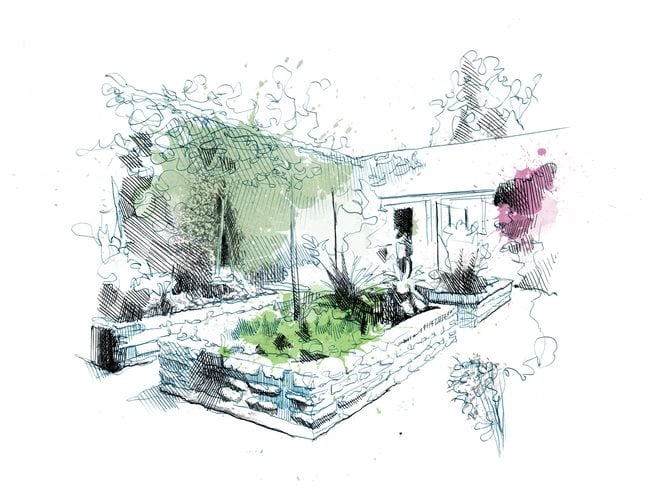
Raised planters in my garden follow the Golden Rectangle. Note, too, the pregnant enclosure provided by the Eugenia hedge. Illustration by David Despau.
04: TURN TO THOMAS D. Church building WHEN DESIGNING STEPS
Another ratio may fifty-fifty be platinum: That'southward what I've always called the rule for step design advocated by landscape architect Thomas D. Church, oftentimes credited with creating the California fashion. Laid out in his seminal work Gardens Are for People, it says but that twice the tiptop of the riser plus the tread should equal 26 inches. That means that if the riser is 5 inches, the tread (what yous walk on) should exist 16 inches. All I can say is that the rule is true, and I've used it from steep canyon faces to gentle changes of patio levels. A useful corollary states that 5 feet is the minimum width for ii people climbing steps next.
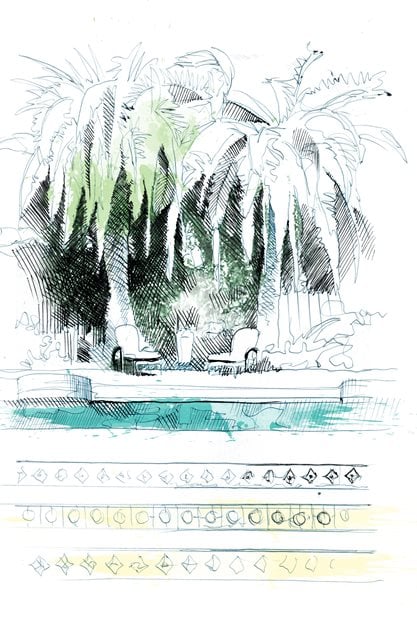
At this Mediterranean inspired garden in the Westwood neighborhood of Los Angeles, the tile-faced steps follow Church's ratio. Illustration by David Despau.
05: SIZE MATTERS
A final rule related to scale and the sculpting of space is this: Go big. Faced with a determination to make a staircase wider or narrower, a pool longer or shorter, a pergola higher or lower, the answer is almost always the former. In my own garden, I remember laying out an arbor, with its posts 10 feet high, and listening to trusted friends wondering whether it wasn't "a footling too tall." Thankfully I stuck to my guns, and some 18 years afterward, wreathed in wisteria and anchored at the basis past clusters of pots, the arbor seems just right.
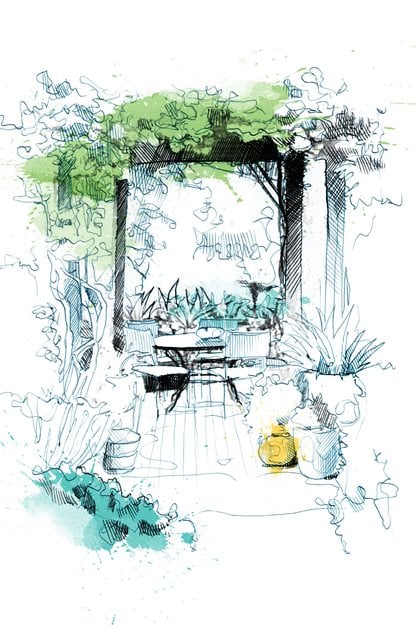
At ten feet, this arbor in my garden allows for hanging and surrounding leaf to intertwine and connect the arbor to the space without infringing on the sense of space. Analogy by David Despau.
06: Establish Large TO SMALL
It'due south with plants, probably more than any other chemical element of gardens, that the infinite variation and fickleness of nature is almost evident—so peradventure, they are the trickiest to prescribe rules for. And all the same, successful planting is the crowning touch of a garden. Three rules have e'er served me well.
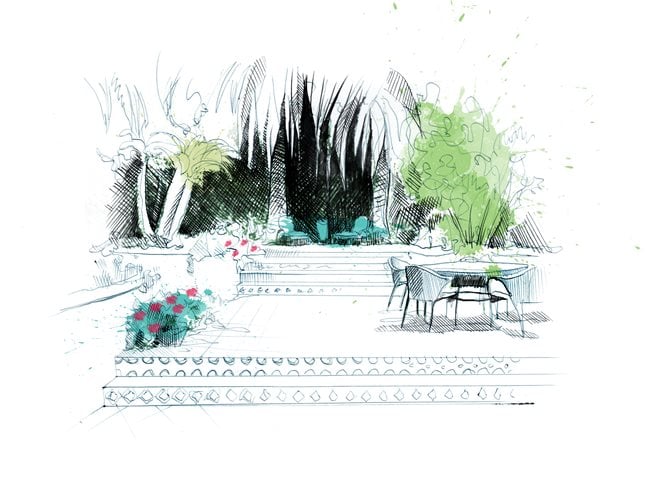
The big palms on this Mediterranean project were already on the belongings; the pepper tree followed. So the hedges and vines were installed. Only after all this were the perennials and containers planted. Illustration past David Despau.
Beginning, is to plant big to small: showtime with trees, then shrubs, then perennials, then basis cover. This is important non but in a compositional style (seeing the bigger forms first gives a better sense of the overall structure), but in a completely practical sense. Setting a large tree may require mechanism or at least multiple gardeners and aplenty space for maneuvering and stationing amendments and soils; it would be sorry to damage or undo some newly planted bed. This seems so obvious, but for lots of gardeners (the author included) a block of fresh perennials may exist incommunicable to avert planting right away. Be strong; resist the temptation.
07: Found IN MASSES
While at that place is much to be said for the cottage garden, with a rich array of varied planting (indeed, it's the real master gardener who tin pull this off), there is a power to seeing a quantity of i plant that is genuinely affecting. Russell Page, one of the great twentieth-century landscape designers said it well: "the most hit and satisfying visual pleasure comes from the repetition or the massing of one simple element. Imagine the Parthenon with each column a dissimilar kind of marble!"
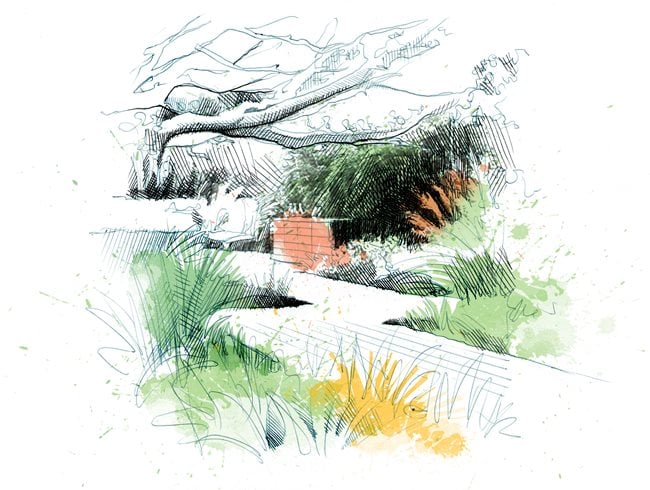
Ornamental grasses, Miscanthus sinensis 'Morning Light' and Sesleria autumnalis flank a garden boardwalk in Pacific Palisades, CA. Using drifts on both sides of the walk reinforces a sense of mass planting. Illustration by David Despau.
I call up as a beginning garden designer in California being taken bated by my mentor, a transplanted Englishwoman who owned the plant nursery, walking through a vast block of salvia, and being told that I could, if I liked, use 30 of them—not the 3 or five I'd typically been planting. It was a liberating moment.
08: Call back THIS In a higher place ALL
Possibly my favorite rule of all time, all the more charming for its need to be adjusted for aggrandizement: It's better to institute a 50-cent plant in a $five hole, than a $5 plant in a l-cent pigsty. Imparted past Ralph Snodsmith, my first official gardening teacher at the New York Botanical Garden and talk radio host (a grapheme whose working compatible was always a wood green iii-slice suit), in that location is no greater planting wisdom. No matter how brilliant a plan 1 conceives, if the plants are non well planted—at the correct height, in a sufficiently sized, and properly amended pit—the results will likely be poor. Some rules just can't be cleaved.
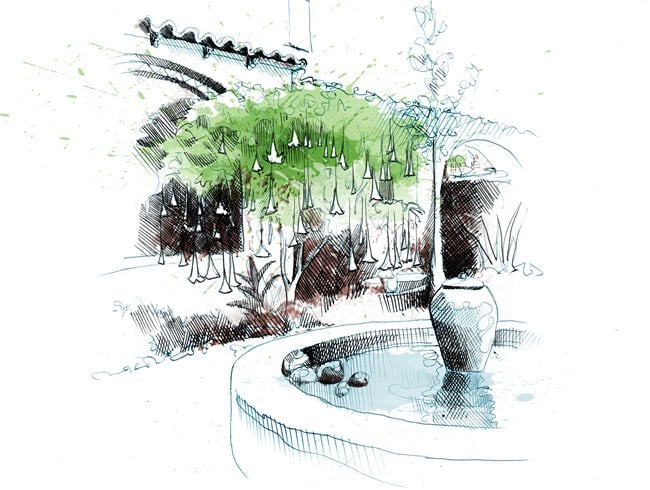
On nevertheless some other project in Pacific Palisades, CA, I planted a Brugmansia versicolor (angel's trumpet). This plant had been banging around in the back of my truck for weeks so I asked the client if they wanted it. With a well-dug and amended hole, it flourished. Illustration by David Despau.
Most THE AUTHORGardens are such personal and private expressions that the very idea that there is a "manner" to create one seems almost insane. And the range of prescriptions about how it should be done—from conventional wisdom such as planting tall plants in the back of the border and short ones in front, to the ironclad strictures of codes, covenants, and restrictions—will stir the insubordinate impulse in whatever artistic soul. Faced with a building code that dictates a 42-inch limit on planting, I will go far a point of accolade to become higher. I am all for a salubrious anarchistic impulse in the garden.
But I am also formally trained, the product of a prestigious Eastward Coast graduate landscape architecture programme—accounted fix to design gardens when I moved west to Los Angeles to begin my career. In fact, as I see it now, I knew only a few things then, and those in a largely theoretical mode. What'southward more, my cognition was to be tested and oft subverted in my new environs. Everything was different: plants, climate, construction technologies—everything. The kickoff time I saw eucalyptus copse hacked into glaze-racks of stubs and stumps, I call back thinking "maybe that's how they're supposed to be pruned." (I got that sorted pretty quickly.) Information technology was some years after—working first in a large part, then in a wonderful plant nursery where I got an intensive class in appropriate planting for Southern California—that I migrated towards residential garden design. There, personal involvement seemed the highest, and the feel of mural the most intimate—just the matter that had fatigued me to the field in the first place.
RELATED:
A Luxe Expect for Less: How to Save Without Sacrificing Fashion
Read most 5 more than landscape design rules on LandscapingNetwork.com.

This article, adapted for the web, originally appeared in the Early Spring 2015 effect of Garden Pattern Magazine under the championship "Rules of the Game."
How To Learn Landscape Design,
Source: https://www.gardendesign.com/landscape-design/rules.html
Posted by: sosakinge1950.blogspot.com


0 Response to "How To Learn Landscape Design"
Post a Comment